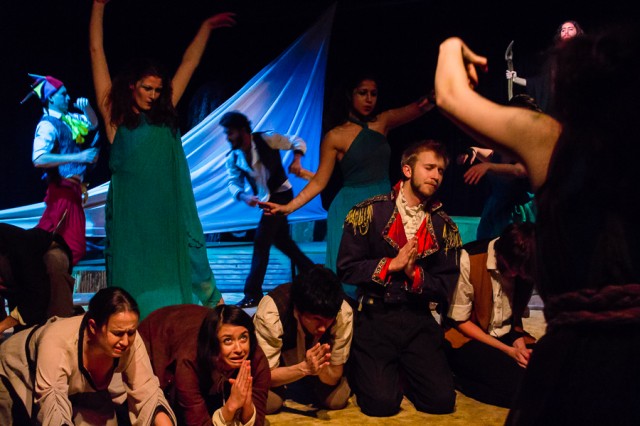Last Wednesday, November 13, Players’ Theatre unveiled its third show of the season, Shakespeare’s alleged last play, The Tempest. Although sticking to the original text, Players’ The Tempest offered a rich visual experience and compelling acting, allowing it to draw contemporary audiences in.
The comedy in question centres around Prospero, the rightful Duke of Milan, as he disbands a group of Neapolitan shipwrecked survivors, including his usurping brother Antonio, in an attempt to play tricks on them. As the story unfolds, Prospero’s loyal spirit Ariel and three mischievous fairies help him manipulate the survivors, who become players in his wicked game of life and death. Fortunately for some, love is found in these unexpected circumstances. Unfortunately for others, Prospero has a few tricks up his sleeve to punish those who wronged him.
Actors […] regularly break the fourth wall and interact with audience members.
While Shakespeare’s humour can be difficult to grasp, the cast of The Tempest deserves praise for the emphasis that they placed on unflowery elocution, which rendered the Bard’s complex text accessible and intelligible. All 18 actors also honoured the reputation of The Tempest as Shakespeare’s most physical play by being as energetic as possible, therefore keeping audience members on the edge of their seats at all times. One way in which this was achieved was through director Juliet Paperny’s ingenious idea to ask actors to regularly break the fourth wall and interact with audience members. Seldom did Caliban, Prospero’s enslaved island monster, miss an opportunity to lock eyes with viewers, which added an appreciated touch of excitement to the production.
The décor, which consisted of artificial sand and water spray-painted onto the ground itself, as well as foliage, trees, nets, boulders, and more, was aesthetically pleasing due to its restrained colour palette which ranged from azure blues to golden yellows. Costumes reflected a historically accurate interpretation of what Italian shipwrecked survivors from the 17th century would have been likely to wear. In terms of makeup and body paint, intricate sinewy designs, as seen on the fairies’ faces, added to the visual pleasure of the play, while tribal patterns and chaotically applied body paint, as seen on Caliban’s body, helped audience members understand characters’ identities.
Yves Abanda’s interpretation of Caliban’s role was one of the high points of the night. His relentless twitching, trembling, grimacing, yelping, jumping, and cascading, which lasted for more than two hours, must have demanded a rigorous physical training and a considerable amount of willpower. The boisterous and expressive Anurag Chaoudhury and Nick LePage, as, respectively, Stephano and Trinculo, were also highly entertaining. The trio, composed of Caliban, the Neapolitan King’s perpetually drunken steward Trinculo, and the jester Stephano, had great stage presence, energy, and complicity. The tricks they played on one another added a welcome slapstick-comedy aspect to the show, complementing the otherwise nuanced humour of the play.
Productions of Shakespeare’s plays are not rare in University-level theatre troupes, and it is therefore prudent to wisely choose which performance to put on before heading brashly into executing what might be a tedious three-hour long play. Paperny’s interpretation of The Tempest, however, is far from monotonous. Au contraire, her fresh new perspective on Shakespeare’s last masterpiece cannot fail to transport audiences to a foreign spatiotemporal zone in which humour, love, and magic reign.
The Tempest will run from November 20 to 23 at 8 p.m. at Players’ Theatre (3480 McTavish, 3rd Floor). Visit ssmu.mcgill.ca/players for more information.


